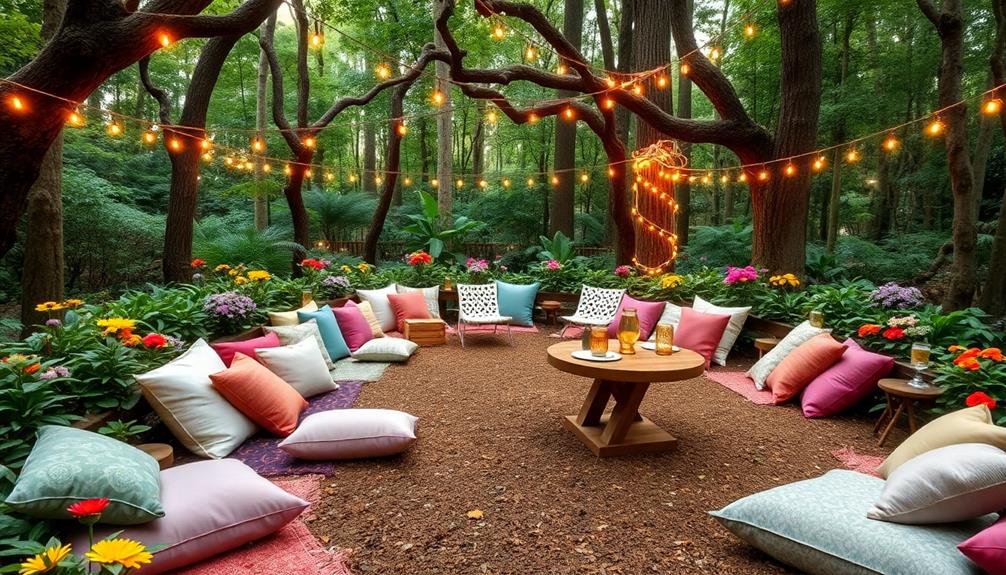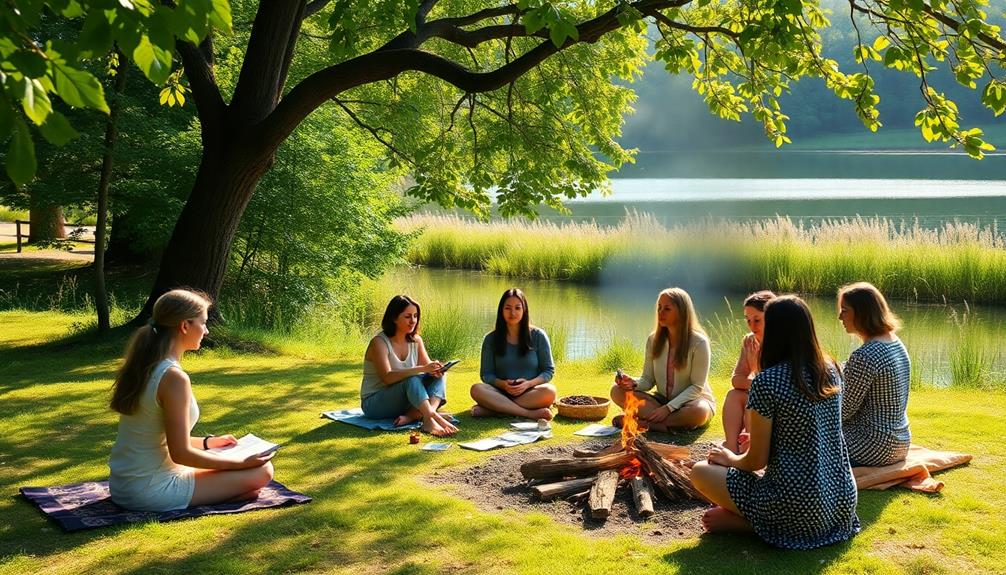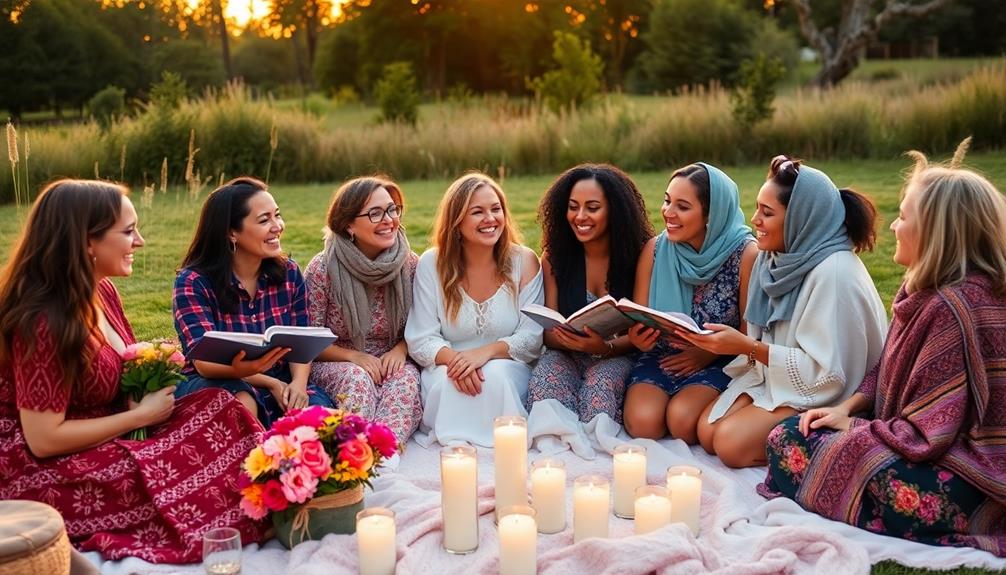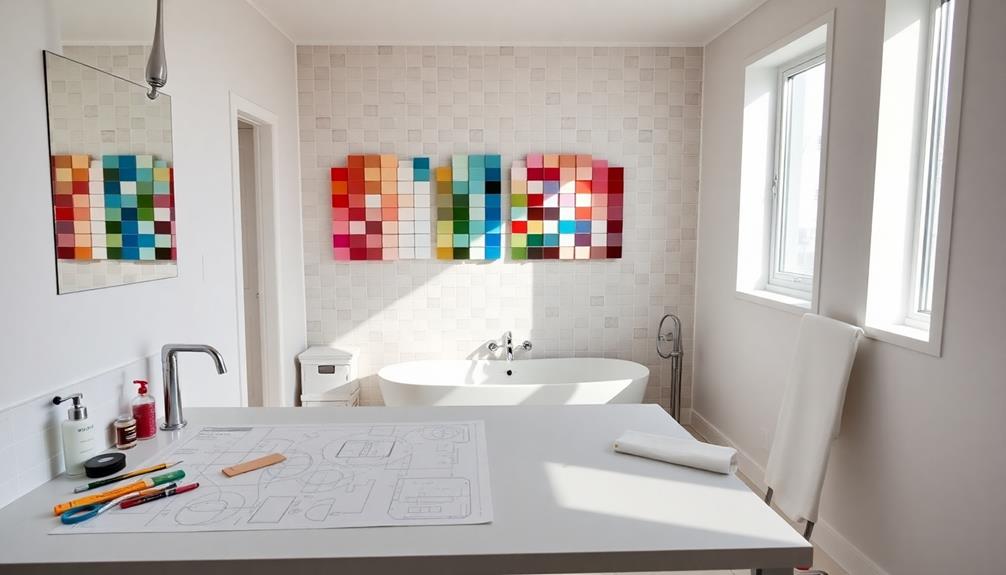Ideas to transform women’s retreats focus on building connections, personal growth, and self-reflection. Incorporating interactive activities like journaling or creative workshops can help cultivate deeper bonds. Choosing meaningful themes such as “Empowerment Through Sisterhood” can guide discussions and activities. Creating a warm atmosphere with natural elements and cozy spaces can enhance the overall experience. Stay connected post-retreat through online communities and regular check-ins. Encourage attendees to set personal goals and celebrate accomplishments together to maintain motivation. These approaches can have a profound and lasting impact, leading to even more ways to foster positive change and strengthen connections.
Key Takeaways
- Incorporate cohesive themes like "Empowerment Through Sisterhood" to guide activities and discussions for personal growth and transformation.
- Engage participants with interactive sessions, such as "Bad Girls of the Bible," to foster insightful conversations and deeper connections.
- Create a welcoming environment with soft lighting, natural elements, and designated reflection spaces to enhance the retreat experience.
- Utilize journaling and goal-setting to empower participants to reflect on their insights and track growth post-retreat.
- Celebrate achievements through ceremonies or visual success boards to strengthen community bonds and reinforce individual progress.
Engaging Activities to Foster Connection

When you step into a women's retreat, engaging activities play an essential role in fostering connection among participants.
You'll find that journaling for self-reflection helps you explore your thoughts and emotions deeply, while creative arts and crafts workshops provide a fun, therapeutic outlet.
Interactive learning sessions, like "Bad Girls of the Bible," spark insightful conversations, allowing you to bond over shared experiences.
Outdoor activities, such as nature walks and scavenger hunts, reconnect you with nature and your spiritual side.
Symbolic rituals like "The Perfect Heart" promote unity and deeper connections.
Team-building exercises and inspirational talks further cultivate a sense of community, motivating you to embrace the transformative journey ahead alongside your new friends.
Meaningful Themes for Transformation

Meaningful themes shape your retreat experience, guiding activities and discussions toward a transformative journey. When selecting a cohesive theme, consider how it resonates with your group's needs and spiritual goals.
Themes like "Empowerment Through Sisterhood" or "Mindfulness and Meditation Oasis" can foster deep connections and personal growth. Aligning your theme with Bible study and prayer sessions strengthens its impact, helping participants reflect and engage.
Explore concepts like community connection and inner strength, using scripture or inspirational quotes to enrich discussions. By focusing on themes that resonate, you'll create an environment where everyone feels valued and encouraged.
Ultimately, these themes set the stage for lasting transformation, ensuring participants leave with renewed purpose and inspiration.
Enhancing the Retreat Environment

Creating a welcoming retreat environment sets the tone for a transformative experience.
You want to foster a space where participants feel at ease and inspired. Here are four key elements to enhance your retreat environment:
- Ambiance and Comfort: Use soft lighting and inviting decor to create a peaceful atmosphere.
- Designated Reflection Spaces: Include quiet areas for contemplation, prayer, and personal reflection.
- Natural Elements: Incorporate outdoor activities and local art to connect participants with nature.
- Comfortable Accommodations: Guarantee restful sleeping arrangements for recharging between activities.
Effective Follow-Up Strategies

After the retreat concludes, implementing effective follow-up strategies is essential for maintaining the connections and insights gained during the experience.
Start by sending out post-retreat surveys to gather feedback, helping you assess what worked and what can be improved.
Creating an online community allows participants to stay engaged and share their experiences, fostering lasting connections.
You might also consider including heartfelt expressions of love to reinforce the emotional bonds formed during the retreat.
Regular newsletters can keep everyone informed about upcoming events and resources.
Schedule follow-up meetings, whether virtual or in-person, to reinforce learning and sustain engagement.
Encourage participants to set personal goals based on their retreat experiences, providing accountability and motivation.
These strategies not only enhance the impact of the retreat but also empower participants to continue their growth journey.
Empowering Participants for Growth

Building on the connections made during the retreat, empowering participants for personal growth is essential for fostering long-lasting change.
You can take actionable steps that will help you integrate your experiences into daily life. Consider these strategies:
- Set Personal Goals: Identify specific objectives you want to achieve post-retreat.
- Practice Daily Reflection: Use journaling to reinforce insights and track progress.
- Engage in Group Discussions: Join or create a community for ongoing support and motivation.
- Utilize Resources: Access tools and materials provided during the retreat to maintain your growth momentum.
Celebrating Achievements and Success

Celebrating achievements and success is essential for reinforcing the growth you've experienced during the retreat and for motivating continued progress.
Take time to acknowledge both individual and collective milestones. Create a space where everyone can share their victories, no matter how small. This practice not only boosts confidence but also fosters a strong sense of community among participants.
Consider incorporating a ceremony or ritual that honors these accomplishments, allowing participants to reflect on their journeys. Use visuals, like a success board, to highlight stories and quotes that inspire.
Measuring the Retreat's Impact

To truly understand the effectiveness of a women's retreat, it's essential to measure its impact.
You can gauge this by focusing on key areas:
- Post-Retreat Surveys: Collect feedback to identify strengths and weaknesses.
- Participation Levels: Monitor engagement during activities to assess interest and connection.
- Success Stories: Highlight individual achievements that emerge from the retreat experience.
- Long-Term Follow-Up: Check in after a few months to see how participants apply what they learned.
Frequently Asked Questions
What Age Groups Are Typically Welcomed at Women's Retreats?
Typically, women's retreats welcome a diverse age range, from young adults in their twenties to seniors in their sixties and beyond. You'll find that inclusivity enriches discussions and fosters connection among participants.
How Can I Prepare for My First Retreat Experience?
To prepare for your first retreat experience, pack comfortable clothing, a journal for reflections, and an open heart. Embrace the opportunity to connect, learn, and grow alongside others in a supportive environment. Enjoy! As you embark on this journey, be mindful of the power in both solitude and shared moments with others. Often, it’s in stillness where profound retreat experiences revealed the inner clarity and peace you’ve been seeking. Trust in the process, for each moment holds the potential for deep transformation and newfound wisdom.
Are Retreats Usually Held In-Person or Online?
Retreats can be both in-person and online, depending on the goals and preferences of the participants. You'll find in-person retreats offer immersive experiences, while online ones provide flexibility and accessibility for everyone involved.
What Is the Typical Duration of a Women's Retreat?
Typically, a women's retreat lasts anywhere from a weekend to a week. You'll find that the duration depends on the goals, activities planned, and the level of engagement desired by participants.
How Much Should I Budget for a Women's Retreat?
When planning your retreat, think of it as planting seeds for growth. Budget around $200 to $500 per participant, covering accommodations, meals, activities, and materials, ensuring a nurturing environment for everyone involved.
Conclusion
As you reflect on your transformative journey, remember that this retreat could be the spark that ignites a thousand flames of personal growth in your life. By embracing connection, exploring meaningful themes, and applying follow-up strategies, you'll not only empower yourself but also inspire others. Celebrate your achievements and carry the lessons learned into your everyday life. Your adventure doesn't end here; it's just the beginning of a vibrant, purpose-driven journey that awaits you. As you move forward, let the themes inspiring modern dance remind you of the fluidity and grace with which you can navigate life’s changes. Just as dance tells a story through movement, so too can you express your personal evolution by integrating these lessons mindfully into your actions. The symphony of growth and creativity you cultivate will resonate far beyond this retreat, shaping your journey ahead.









